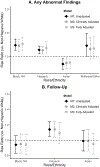Racial and Ethnic Disparities in Cervical Cancer Screening From Three U.S. Healthcare Settings
- PMID: 37146839
- PMCID: PMC11135625
- DOI: 10.1016/j.amepre.2023.04.016
Racial and Ethnic Disparities in Cervical Cancer Screening From Three U.S. Healthcare Settings
Abstract
Introduction: This study sought to characterize racial and ethnic disparities in cervical cancer screening and follow-up of abnormal findings across 3 U.S. healthcare settings.
Methods: Data were from 2016 to 2019 and were analyzed in 2022, reflecting sites within the Multi-level Optimization of the Cervical Cancer Screening Process in Diverse Settings & Populations Research Center, part of the Population-based Research to Optimize the Screening Process consortium, including a safety-net system in the southwestern U.S., a northwestern mixed-model system, and a northeastern integrated healthcare system. Screening uptake was evaluated among average-risk patients (i.e., no previous abnormalities) by race and ethnicity as captured in the electronic health record, using chi-square tests. Among patients with abnormal findings requiring follow-up, the proportion receiving colposcopy or biopsy within 6 months was reported. Multivariable regression was conducted to assess how clinical, socioeconomic, and structural characteristics mediate observed differences.
Results: Among 188,415 eligible patients, 62.8% received cervical cancer screening during the 3-year study period. Screening use was lower among non-Hispanic Black patients (53.2%) and higher among Hispanic (65.4%,) and Asian/Pacific Islander (66.5%) than among non-Hispanic White patients (63.5%, all p<0.001). Most differences were explained by the distribution of patients across sites and differences in insurance. Hispanic patients remained more likely to screen after controlling for a variety of clinical and sociodemographic factors (risk ratio=1.14, CI=1.12, 1.16). Among those receiving any screening test, Black and Hispanic patients were more likely to receive Pap-only testing (versus receiving co-testing). Follow-up from abnormal results was low for all groups (72.5%) but highest among Hispanic participants (78.8%, p<0.001).
Conclusions: In a large cohort receiving care across 3 diverse healthcare settings, cervical cancer screening and follow-up were below 80% coverage targets. Lower screening for Black patients was attenuated by controlling for insurance and site of care, underscoring the role of systemic inequity. In addition, it is crucial to improve follow-up after abnormalities are identified, which was low for all populations.
Copyright © 2023 American Journal of Preventive Medicine. All rights reserved.
Figures


References
-
- SEER*Stat Database: Mortality - All COD. Aggregated with state, total U.S.; 1990–2018. Surveillance, Epidemiology, and End Results (SEER) Program DCCPS, Surveillance Research Program, Surveillance Systems Branch. Published April 2021. https://seer.cancer.gov/statistics-network/explorer/application.html?sit.... Accessed February 9, 2022.
-
- SEER*Stat Database: Incidence - SEER 13 Regs Research Data. Sub (1992–2018), Epidemiology, and End Results (SEER) Program; 2020. National Cancer Institute, DCCPS, Surveillance Research Program, Surveillance Systems Branch. Surveillance (www.seer.cancer.gov). Published April 2021. https://seer.cancer.gov/statistics-network/explorer/application.html?sit.... Accessed February 9, 2022.
-
- Matz M, Weir HK, Alkhalawi E, Coleman MP, Allemani C, US CONCORD Working Group. Disparities in cervical cancer survival in the United States by race and stage at diagnosis: an analysis of 138,883 women diagnosed between 2001 and 2014 (CONCORD-3). Gynecol Oncol. 2021;163(2):305–311. 10.1016/J.YGYNO.2021.08.015. - DOI - PMC - PubMed

